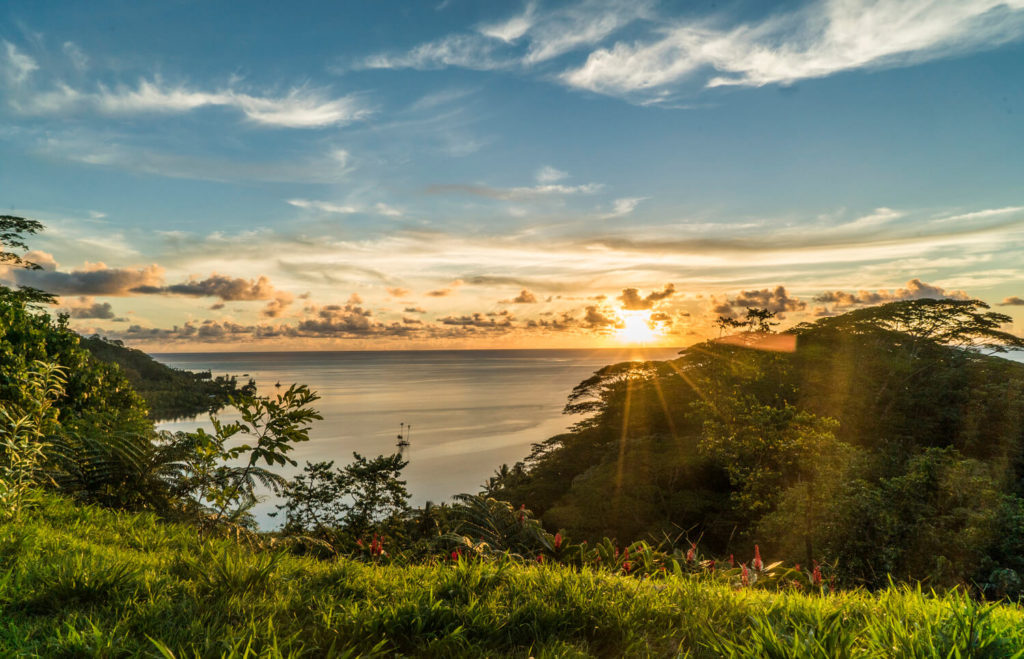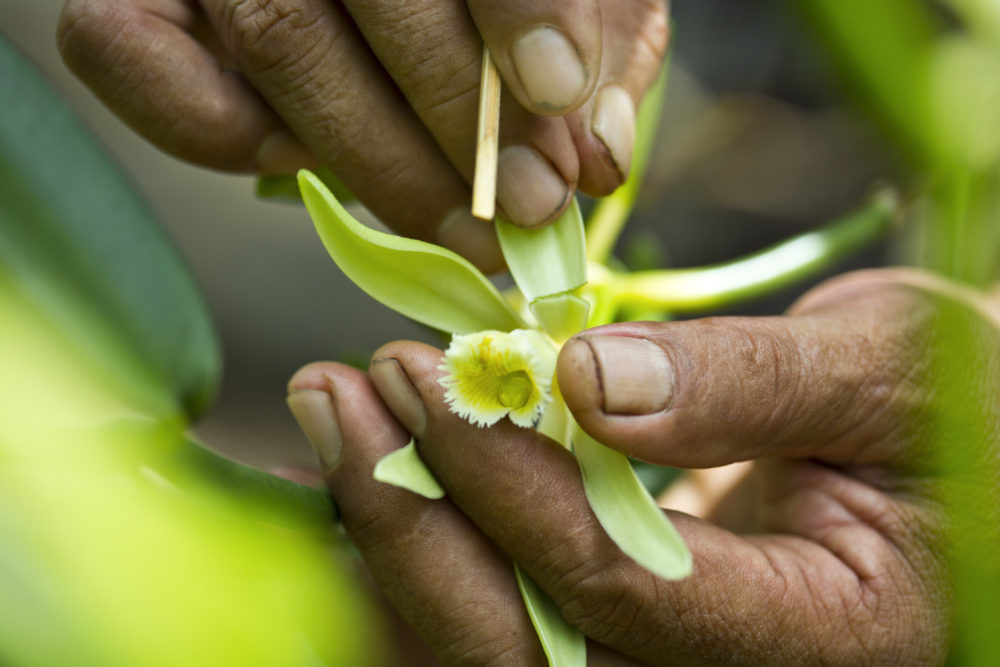Raiatea: the beautiful Polynesian island

07/10/2022
Originally called Havai’i Nui, the island of Raiatea in French Polynesia holds particular significance in the lives of all French Polynesians.
Less known than Bora Bora, Raiatea is the second largest island in the group of Society Islands and is considered to be the cradle of the ancestors and the homeland of the Māori people, as it is likely that the organised migrations of people to the Hawaiian Islands, New Zealand and other parts of East Polynesia started with travel from Raiatea.
Raiatea is also an incredible natural source of interest for scientists and nature lovers due to its rare flora and fauna. Mount Temehani shelters the Tiare Apetahi (and about 30 other endemic plants), a flower found nowhere else in the world. It has become the symbol for Raiatea with a half-circle of white petals, this delicate flower only blooms at dawn.
Where is Raiatea ?

© Audrey Svoboda
Raiatea is located 230 km northwest of Tahiti and a 20 minute flight from Bora Bora, making travel to Raiatea and relatively easy island hop. It is the largest island in the Leeward islands and the second largest island in the Society Islands archipelago. A coral reef surrounds the islands of Raiatea and neighbouring island of Tahaa and they share the same lagoon. Its capital, Uturoa is the administrative capital of the Leeward Islands and the second largest urban centre of French Polynesia, after Papeete (Tahiti).
The main island is of volcanic origin and consists mainly of igneous rocks. On the fringing reef and in the lagoon there are many beautiful white coral sand motu. The island of Tahaa extends north of Raiatea, and the two islands are separated by a 3 km strait. According to legend, it is the work of an enchanted moray eel possessed by the spirit of a deceased princess. The boat trip from Raiatea to Tahaa across the lagoon takes only 20 minutes. Raiatea's landscape is characterised by rugged peaks, a heavily indented coastline with deeply indented bays with numerous small, tiny islands, or Motu, located in the lagoon.
The most beautiful sandy beaches are found on these motu, while the rocky coastline of the main island of Raiatea has few beaches. From the peaks, the highest of which is Toomaru at 1032 m, 10 steeply sloping valleys and gorges open out to the sea, separated by narrow rocky ridges. The numerous streams often form spectacular waterfalls. The eastward-flowing Apoomau River rises in the 1017 m high Tefatoatiti mountains and flows into Faaroa Bay. It is the only navigable river in Polynesia and, depending on the water level it can be traversed by small boats for a few kilometres.
What is the best season to go to Raiatea ?
The climate on the island of Raiatea is tropical and humid with an average annual temperature of 26°C. The driest months are August and September, and the wettest month is December with annual rainfall at about 1800 mm. However, there is little difference in the weather across the year making the island a beautiful year-round destination. The season in which you decide to go Raiatea will obviously influence the cost of your trip.
Discover Raiatea with Aranui 5
Alternatively, cruise passengers can discover Raiatea aboard the passenger/cargo ship Aranui 5 on its brand new nine-day lagoon-hopping cruise itinerary of the Cook & Society islands
Passengers will disembark the ship and visit Taputapuatea, the 1,000-year-old marae temple complex and a UNESCO World Heritage Site, which is regarded as the religious and spiritual centre of all of Eastern Polynesia. Passengers will also visit the town of Uturoa and see the fabulous flora and fauna of Mount Temehani, the island’s most sacred mountain. The mountain is home to the rare Tiare Apetahi, a flower found only on Raiatea, and whose delicate white petals only bloom at dawn.
What to see on the island of Raiatea ?

© Tahiti Tourisme
The main attraction on the island of Raiatea is the temple complex of Taputapuatea. It comprises several worship platforms (marae) that were originally distributed in a sacred grove surrounded by tabu.
The sacred site was the centre of religious and political power of the Polynesian region and the meeting place for inauguration ceremonies, political alliances, and international gatherings. Today the communities of Hawaii, New Zealand and the Cook Islands still meet at this pilgrimage venue, which they consider as the home of their sacred culture.
The largest platform was built in the early 17th century with huge upright limestone slabs and is dedicated to Oro, the god of war.
There are other important ceremonial sites on the island. In the Avera valley, north of Opoa on the east coast, is another large ceremonial platform. Nearby, archaeological excavations have uncovered the remains of dwellings and stone tool workshops. The ceremonial site at Tainuu, on the northwest coast, is also well preserved. In addition to the imposing coral rock slabs with which the marae was delineated, petroglyphs are also preserved here. On this site, sacred to the Polynesians, missionaries built a church in the 19th century.
What activities can we do ?
In addition to seeing the marae temple complex and a UNESCO World Heritage Site of Taputapuatea, one of the main activities visitors to Raiatea can do is dive and snorkel in the clear waters of the lagoon. The fauna of the lagoon and coral reef is rich in marine life. In addition to hundreds of different coral fish, divers can observe numerous molluscs, echinoderms, and crustaceans from the tropical sea.
The waters surrounding Raiatea are known for their rich population of colourful Nudibranchs (soft-bodied marine gastropod molluscs). The island’s reefs are dotted with grottoes and caves that provide shelter for marine creatures, with the "octopus grotto", located between Raiatea and Tahaa, being the best known to divers. Beyond the reef divers might also see sharks, rays, swordfish, and sea turtles. The wreck of the Nordby, a Danish trimotor that sank around 1900 is an interesting destination for divers. The wreck, which is very well preserved, is located at a depth of about 20 m, near to the Pearl Beach Resort on the northeast coast.
What to bring in your luggage for Raiatea ?
For your visit to Raiatea, it is best to dress for a tropical climate with plenty of shorts and T-shirts or short-sleeved shirts. If you want to dress like a local resident in French Polynesia, on most days, you will see woman wearing pareos (sarongs) as everyday dress or other lightweight clothing such as sun dresses.
Bring sturdy and comfortable shoes for walking and as your time on the island is likely to include water activities, it is best to pack at least two bathing suits, along with water shoes, as some parts of the ocean floor are likely to be covered in coral.
If you are visiting in the rainy season, a lightweight waterproof/windproof jacket is advised and to keep the sun off your head pack a casual hat that can scrunch up in your bag, get wet, and won't blow off in wind.
Would you like to discover Raiatea? Check out our cruises in French Polynesia:
- Bora Bora Cruise
- Tahiti Cruise
- Marquesas Islands Cruise
- Austral Islands Cruise
- Cook Islands Cruise
- Pitcairn Islands Cruise
- Society Islands Cruise
- Tuamotu Islands Cruise
- Gambier Islands Cruise

Read also



